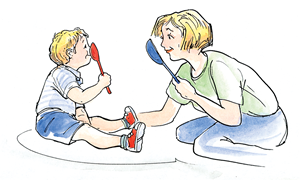Imitate to Connect! Sparking Interactions with Young Autistic Children
By Lauren Lowry and Lesia Partyka
Hanen Certified SLPs and Clinical Staff Writers


When supporting the social communication skills of young autistic children, interaction always comes first! When you have back-and-forth interactions with your child, you have many opportunities to support their social communication skills while having fun together.
You may be wondering how you can join your child in their play and get an interaction started. Your child may have their own unique interests or enthusiasms and you may not be sure how to join them in these activities. You may have tried playing beside your child or talking about what they are doing but find you haven’t been able to get the interaction started. Imitating your child is a fun and easy way to join in their play.
The Power of Imitation
Throughout childhood, children learn a lot about communication by watching and imitating the people around them. But did you know a lot can happen if you imitate them? In fact, imitating your child can be one of the most powerful ways to get an interaction going with your child. Here are some tips for using the Imitate strategy from the Hanen More Than Words® Program that can help you spark an interaction between you and your child.
Three Steps to Imitate Your Child
1. Observe what your child is doing
Notice what your child is doing and what your child is interested in by observing them closely. Is your child moving their body? Doing an action with a toy or object? Making any sounds?
2. Copy what your child is doing
 Do exactly what your child is doing. If your child is running back and forth and making the “ahh” sound, run beside them and make the “ahh” sound too. If your child is playing with a toy or object, get your own toy or object and copy your child’s actions. You need to have your own toys or objects when you are imitating your child. The toys or objects you imitate them with do not have to be the same but should be similar. Some children like to keep their toys as a “set” (i.e. all the cars as a “set” or a “whole”). If you notice your child isn’t pleased when you pick up another toy that looks the same, you can imitate with a similar looking toy that is not part of the “set”. For example, if your child is pushing a car down a ramp, you can pick up a block and push the block down the ramp.
Do exactly what your child is doing. If your child is running back and forth and making the “ahh” sound, run beside them and make the “ahh” sound too. If your child is playing with a toy or object, get your own toy or object and copy your child’s actions. You need to have your own toys or objects when you are imitating your child. The toys or objects you imitate them with do not have to be the same but should be similar. Some children like to keep their toys as a “set” (i.e. all the cars as a “set” or a “whole”). If you notice your child isn’t pleased when you pick up another toy that looks the same, you can imitate with a similar looking toy that is not part of the “set”. For example, if your child is pushing a car down a ramp, you can pick up a block and push the block down the ramp.
3. Watch and see how your child responds
As you copy your child, observe how they respond to you copying them. They might smile, quickly glance over to check out what you’re doing, or keep the game going by doing their action again. All of these are great signs because it means you’ve started an interaction! Keep imitating your child so that the interaction continues, with you and your child noticing each other’s actions.
You may get the interaction started quickly or it may take time. If you are unable to get the interaction going, you can try to imitate your child in other activities to see if an interaction gets started when you imitate in a different activity. Sometimes children are used to adults changing their play, so it can take a bit of time for them to see that you are copying them and not trying to "take over" their play idea. Be patient. It can take time to get the interaction started.
Once You Have the Interaction Going, Support Your Child to Imitate You!
If you get a back-and-forth interaction going by imitating your child, there is one more step you can try – You can add something new and related to the game. This creates an opportunity for your child to imitate a new action, sound, word, or play idea and keeps the interaction going even longer.
How to add something new and related to the game
If your child is having fun and you have an interaction going, try adding something new to the copycat game. The new action should be related to what your child is already doing. For example, if your child is running back and forth saying “ahh”, you can keep running but add a different sound while you run like “eee”. Or you could try running in a different direction while you say “ahh”. If your child is pushing a car along the floor, you could add something new by pushing it up a ramp, or by bumping your car into your child’s car. You don’t want to change the nature of the game – your child is playing in a way that is fun for them, so the new action should be just as fun, and it should match their play idea.
After you’ve added a fun, new action to the game, stop and wait to see what your child does next. If your child doesn’t notice or doesn’t like the new action, go back to copying what your child is doing. But if your child notices the action and likes it, they might try to copy it. If they copy it, great! Keep imitating the new action back and forth. If your child goes back to their original action or does something different, copy that to keep the interaction going.
Having Fun Is What’s Most Important
The most important thing to remember is to have fun together and to keep the back-and forth-interaction going. Don’t introduce too many new ideas or change the game – stick with your child’s play idea and add a new action that is related to their idea. By joining in with your child in the way they like to play, you can support their social communication skills while having fun together!
For more ideas on using imitation to help build social communication skills,
take a look at our guidebook, More Than Words.